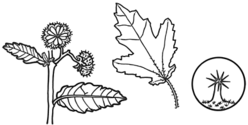Commersonia hermanniifolia J.Gay ex Kunth APNI* Synonyms: Rulingia hermanniifolia (J.Gay) Endl. APNI*

Description: Prostrate or trailing shrub, stems to 1 m long.
Leaves discolorous, oblong to lanceolate, mostly 0.5–2 cm long, 4–15 mm wide, sometimes lobed and larger in juveniles (up to 4 cm long and 3-lobed at base with petiole 10–30 mm long in new growth after fire), apex obtuse, margins irregularly crenate, recurved; upper surface strongly wrinkled, glabrous, or towards margins with stellate hairs, glandular trichomes absent, lower surface densely tomentose, with white or white with brown-centred, sessile, stellate hairs, above dense, smaller, white, stellate hairs, glandular trichomes absent; petiole 0–4.8 mm long.
Inflorescence cymes, few-flowered, longer than petioles. Calyx c. 2 mm long. Petals c. 2 mm long, pinkish.
Capsule 4–6 mm diam., outer surface tomentose with very short stellate hairs beneath bristles c. 1 mm long throughout; shaft with or without occasional, clavate, glandular trichomes; apical hair with erect and horizontal arms; fruits mostly summer.
Distribution and occurrence: Mostly confined to coastal areas from Broken Bay to Botany Bay, also south to Jervis Bay, and along the Shoalhaven River. Often spreads 1-2 m across ground or pendent down rock faces, mostly on sandstone cliffs or along gullies; rare.
NSW subdivisions: CC, SC
Most similar to C. breviseta, which has fruit bristles only towards the apex. Also, upper leaf surface retains its dense, stellate hairs and it is a taller, erect plant.
Text by B.J. Conn (2014); modified S.F. McCune (2019)
Taxon concept: Wilkins and Whitlock (2011) Australian Systematic Botany 24(5):277-279
APNI* Provides a link to the Australian Plant Name Index (hosted by the Australian National Botanic Gardens) for comprehensive bibliographic data
***The AVH map option provides a detailed interactive Australia wide distribution map drawn from collections held by all major Australian herbaria participating in the Australian Virtual Herbarium project.
|


